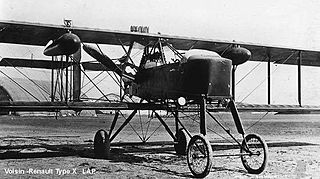
The Farman F.220 and its derivatives were thick-sectioned, high-winged, four engined monoplanes from Farman Aviation Works. Based on the push-pull configuration proven by the F.211, design started in August 1925 and the first flight of the prototype was on 26 May 1932. The definitive F.222 variant was the biggest bomber to serve in France between the world wars. One variant was designed as an airliner.

The Voisin III was a French World War I two-seat pusher biplane multi-purpose aircraft developed by Voisin in 1914 as a more powerful version of the 1912 Voisin I. It is notable for being the aircraft used for the first successful shooting down of an enemy aircraft on October 5, 1914, and to have been used to equip the first dedicated bomber units, in September 1914.

The ANF Les Mureaux 110 and its derivatives were a family of French reconnaissance aircraft developed in the 1930s. They were all-metal, parasol-wing monoplanes that seated the pilot and observer in tandem open cockpits. The aircraft were widely used in the Battle of France, but were all scrapped soon thereafter.

The Caudron R.4 was a French World War I twin-engine biplane reconnaissance/artillery cooperation aircraft and the progenitor of a series of successful aircraft that filled a variety of roles with the French Aéronautique Militaire.

Aéroplanes Voisin was a French aircraft manufacturing company established in 1905 by Gabriel Voisin and his brother Charles, and was continued by Gabriel after Charles died in an automobile accident in 1912; the full official company name then became Société Anonyme des Aéroplanes G. Voisin. During World War I, it was a major producer of military aircraft, notably the Voisin III. After the war Gabriel Voisin abandoned the aviation industry, and set up a company to design and produce luxury automobiles, called Avions Voisin.

The CAMS 55 was a reconnaissance flying boat built in France in the late 1920s which equipped the French Navy throughout the 1930s.

The Caudron R.11, was a French three-seat twin-engine long range escort fighter biplane developed and produced by Caudron during the First World War.

The FBA Type H was a French reconnaissance flying boat produced in large numbers in France and Italy during World War I by Franco-British Aviation.

The SPAD S.XII or SPAD 12 was a French single-seat biplane fighter aircraft of the First World War developed from the successful SPAD VII by Louis Béchereau, chief designer of the Société Pour L'Aviation et ses Dérivés (SPAD).

The Letord Let.5 was probably the most numerous of a family of 3-seat reconnaissance bombers, designed and built in France from 1916, originally to an A3 specification from the STAé.

The Vickers F.B.25 was a British two-seat night fighter prototype of World War I designed to attack enemy airships. Completed in 1917, it failed in its official flight tests that year and no order for production resulted.
The Adolphe Bernard AB was a twin-engined French biplane aircraft, built near the end of the First World War. Ten AB 1 BN2 bombers were produced for the Armée de l'Air but did not reach squadron service; post-war, two civil derivatives were considered but only one aircraft was built.

The Voisin Triplanes were large experimental bombers built by Voisin in 1915 and 1916. After unsuccessful trials of the 1915 prototype a modified version with more powerful engines was built in 1916, as the Voisin E.28, but the type did not enter production.
The Voisin VI or Voisin Type 6 was a French pusher biplane bomber aircraft of World War I.
The Tellier T.2 was a French two-seat patrol biplane flying-boat built by Société Alphonse Tellier et Cie à Neuilly (hull) and Voisin (wings). The wooden-hull flying boat used a 150 kW (200 hp) Hispano-Suiza 8Ba engine and was first flown in June 1916.
The Blériot 71 was a large First World War French heavy night bomber designed and built by Blériot to the BN3 specification. Only a single prototype was built, which was damaged beyond repair on 15 May 1918.
The Blériot 73 was a large First World War French heavy night bomber designed and built by Blériot to the BN3 specification. Only a single prototype was built, which crashed on landing from its first flight, killing the pilot. The Blériot 74, Blériot 75 and Blériot 76, respectively, a heavy bomber / airliner, airliner and heavy bomber, directly evolved mfrom the Blériot 71 / Blériot 73 bombers.

The Voisin VIII was a French two-seat biplane pusher which was built in two versions, one fitted with a 37mm Hotchkiss cannon, and the other as a conventional bomber. Problems with the Peugeot engine led to a short operational career with front line units before being superseded by the Voisin X, which aside from the installation of a new Renault engine, was nearly identical to the VIII.

The Voisin X was a French two-seat pusher biplane which was built in two versions, one fitted with a 37 mm (1.46 in) Hotchkiss cannon, and the other as a conventional night bomber. Problems with the Peugeot engine in the previous Voisin VIII led to the installation of a new Renault engine of greater power and reliability, but the new aircraft was otherwise nearly identical to the VIII. Despite its obsolescence, it would make up the bulk of front line night bomber escadrilles until the end of the war.

The Voisin IV was a French two-seat bomber and ground attack aircraft of World War I.

















